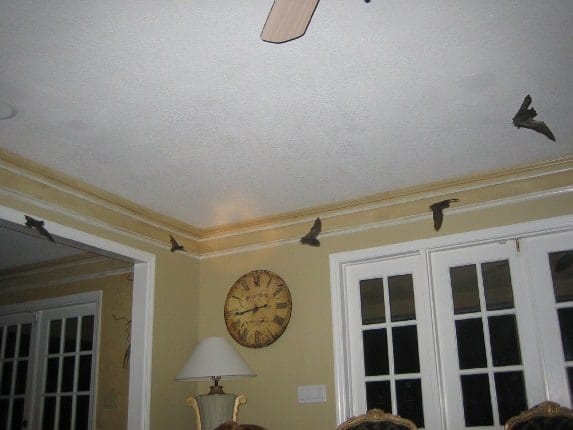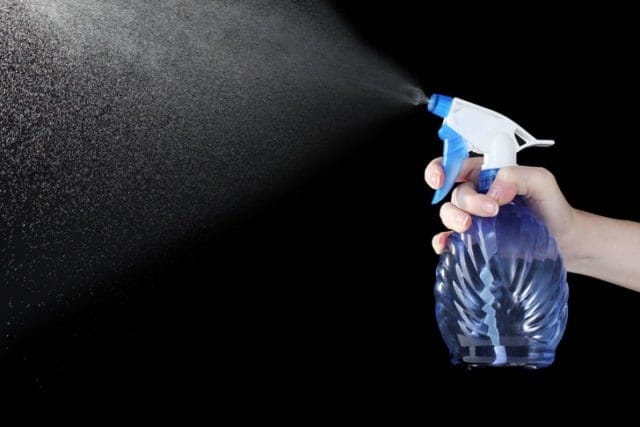Bat-infestation is more widespread than one would like to accept or even think. Although bats may not necessarily cause harm and are actually a great help in removing insects from the house, their droppings may harm your body and affect your health– the main illness being histoplasmosis, which manifests in the form of flu-like symptoms.
If you face bat-related problems and want to know how to keep them away, look further, with these home remedies to get rid of bats.
Before the process to get rid of bats start, you must first find their hiding place. Usually, the unpleasant smell of the bat droppings will help you find their hiding place. If you are unable to locate them by their smell, you can search for places where bat poops are present.
Few common places where you can expect these uninvited and unwanted guests are attic, old unused things/ rooms, where dormer meets the roof, and the porch connect with the main segment of the house, the pergolas on the terrace that you hardly use, in the backyard where you have kept old furniture and more.
It is easy to evacuate bats only but only when you find their refuge.
Table of Contents
Causes Of Bat – Infestation

The following are the common causes why bat makes your home their home-
1. Entry Points In The Form Of Holes
Bats can enter your house from even the smallest of the holes. So if any hole is present in your house, you should be careful and cautious of bat-infestation.
2. Rooms Left Unused
Any room if left uninhabited for a long time may become a new home for the bats and bats like to live in dark places where no one comes.
3. Collection Of Old Furniture
Old, antique furniture’s are full of dust and nobody uses them. This then becomes an ideal place for a bat.
4. Chimneys And Other Similar Structures
A chimney if left uncleaned becomes a hiding place of bats. They will then cause diseases.
5. Dirty Corners In The House
Dirty corners are an ideal place for a bat to hide as bats like to live in dark, untidy places.
6. Lack Of Protective Netting On Doors And Windows
Bats may enter your house unannounced if there is no protective netting on the doors and windows of your house.
Symptoms Of Bat Infestation
Symptoms that can tell you that your house is bat-infested:-
- Squeaking, scratching sounds coming from the walls or from unused rooms at dusk or dawn.
- Presence of guano
- White streaks on the wall which happens due to bat urine
- Strong, unpleasant smell, possibly coming from the urine or guano
- Accumulation of dirt and grease on the walls
- Presence of bats around the house or in your immediate surrounding
- Rub marks on holes or cracks in the building
Home Remedies To Prevent Bats
A. If Bats Are Outside The Building
1. Moth Balls

If your house is bat-infested, using mothballs may be the best method to get rid of the bats. They are also called naphthalene balls and are easily available at pest control stores.
Older mothballs consisted mainly of naphthalene, but due to its flammable nature, most of the modern mothball consist of 1, 4-dichlorobenzene. This modern combination may be less flammable, although both combinations have a similar rating for flammability.
How To Use It?
Tie some moth balls in a soft piece of cloth and put or hang them around the house.
Cons Of Using Mothballs
- Once the balls dissolve, the smell also vanishes, thus inviting bats back to the house.
- Even the use of 500 lbs of mothballs, it is not enough to keep out bats permanently.
- When placed in enclosed areas, even humans can get affected by it.
- Pets or kids if intake they can be dangerous to health. Sometimes it can even lead to death.
2. Eucalyptus Or Peppermint

The Eucalyptus oil is the general name for distilled oil from the leaf of Eucalyptus.
It has a wide variety of application in areas such as pharmaceutical ,antiseptic, repellent, flavoring, fragrance and industrial uses. The leaves of selected Eucalyptus species are steam distilled to extract eucalyptus oil. The odor of both of these things is anathema to bats and they cannot stand it.
How To Use It?
Try using eucalyptus oil or eucalyptus-based gels to repel bat from your home.
3. Cinnamon
Cinnamon is a tree and the bark of the tree is what is used as a spice. It has been used for many centuries for aromatic purposes. The spice has also been recognized for its healing benefits for numerous ailments, partially due to its antifungal and antimicrobial properties.
Powdered cinnamon is also very efficient in making bats and other insects go away.
How To Use It?
- Sprinkle somewhere bats are present, and see results right away.
- Add a few drops of cinnamon oil to your favorite lotion or sunscreen and make your own natural and safe insect repellant.
- Break 4 cinnamon sticks and combine with 1/2 cup of whole cloves and 1/2 cup whole black peppercorns. Fill small squares of fabric with a tablespoon of this mixture, tie shut and hang in your closets.
4. Phenol
Phenol, also known as carbolic acid, is an aromatic organic compound with the molecular formula C6H5OH. The smell of phenol irritates these creatures of the night, so it is an effective home remedy to make your house bat free.
How To Use It?
Buy white phenol and keep it in a spray bottle – use this as bat spray in all the bat-infested areas. Keep repeating this process until smell becomes unbearable and the bats go away.
5. Close All Holes And Cracks
Perhaps the most simple and basic way to ensure that no bats enter or reenter in the house is by repairing all the walls in the house. Close all holes, cracks, and crevices, and replace or fix broken or cracked tiles.
Bats can enter even through a small area, even holes that are as small as having half inch a width, so this is the basic and best way to keep bats away from house permanently.
6. Sealants
After ensuring that all bats have left at night in search of food, clean out their nesting region(s) and cover them with sealants or nets.
Make sure you use enough amount of these to keep them from entering again. Put moth balls in these area to keep them away permanently.
7. Aerosol Repellent
Use aerosol dog or cat repellent in the bat-infested areas, but do this only after ensuring that bats have left the area, at least for some while, otherwise you may harm them or even cause them to die, and killing bats is illegal in certain places in the world, as well not advised generally, as they are very helpful in maintaining stability of ecosystem.
8. Other Repellents
Specific bat repellants are available in the market in the form of gels and sprays. Use these to chase away bats.
9. Water Spray

This seems simple but is very effective. Keep spraying water in bats-infested areas to get them to move out. In this way, the bats will gets annoyed without causing harm to them in any way.
Once the bats leave after being sprayed with water many times, close up and seal that region.
10. 4-The-Birds Gel
A sticky anti-bat gel available everywhere in the world, it is very effective in keeping bats away if applied onto entry points. Bats avoid landing on gels, so a generous use of this product will ensure that they leave.
11. Aluminum Foil

Aluminum foil is great for use at the entry points as well as nesting regions of the bats.
How To Use It?
Hang some in bat-infested areas and see the bats leave. The hangings cause a chime-like sound when hanged and also work as surfaces with great reflective powers– both sound and light annoy bats and make them leave.
12. Mylar Balloons
This is without a doubt one of the most efficient ways to keep bats away.
How To Use It?
When all the bats have left, hang Mylar balloons that are filled with helium, at the entry points to ensure that bats do not enter the house again when they return. If done continuously, the balloons will definitely keep bats away.
13. Mirrors
Mirrors have the same principle as an Aluminum foil.
How To Use It?
Hang small mirrors in bats nesting region and use enough amount of light to light these areas. The reflection will annoy the bats and keep them away.
14. Ultrasonic Sound Emitter Devices
Although there is no proof that they are very effective, they are worth a try.
15. Christmas Decor
This is an odd remedy, but the bright, shiny bulbs, balls, and other glitzy material will annoy the bats and prevent them from entering their nesting regions if placed or hung around the entry points.
16. Check Valve
Check valves, allows only one-way movement if the place at entry points they will ensure that bats leave and do not return again. Once they have left, seal the areas well.
17. Bat Houses
Install bat houses to keep them away from your house and also ensuring that they have place to rest and eat safely.
18. Fiberglass Insulation

Fiberglass is a material known to annoy bats. So if they are kept in bats-infested areas, the bats will most likely to leave.
19. Insecticides
This will help you get rid your house of bats in an indirect way. Use an insecticide to get rid of insects in your house. No insects, no bats.
B. If The Bats Are Inside The Building
1. Choose The Right Time Of Year
- Evacuating bats during the right season is necessary to their overall survival.
- Find out if you have to deal with a nursing colony. If you remove the adult bats before the pups can fly out, they’ll die in the building.
- Try to avoid getting rid of bats in the winter. Bats typically hibernate during the cold season, and there won’t be enough food for them to survive outside.
2. Locate Points Of Entry
Look for bat droppings near the entrance. Bat droppings have small pieces of insect shells, so they’re sparkly in the sunshine and crumbly in texture.
Try avoiding to inhale the bat droppings. You can get flu-like symptoms. If you can’t identify the openings by the droppings, watch carefully to see where they emerge from at night.
These are some common points of entry like Broken or poorly-fitted screens
- Places where flashing or boards have come loose
- Loose or missing shingles or tiles
- Locations where pipes or wiring enter buildings
- Where porches attach to the main part of a house
- Where walls meet the eaves at the gable ends of an attic
- Dormers meet the roof
- At places where it meets windows, doors or chimneys,
- Cracks and crevices where siding forms corners
3. Prevent Re-Entry
Once you’ve evacuated the bats, you’ll need to keep them from getting back in. There are two ways to go about doing this.
- Perform repeated sealings. After they leave at night to feed, fix a screen or fine hardware cloth over the opening. By the next night, only some of them will be gone, so you’ll need to remove the covering so the stragglers can leave to feed. This can be pretty time-consuming if there are many openings throughout the building, as bats typically won’t use alternate exits.
- Use one-way devices. Once all the bats are gone, the devices are removed and the holes are permanently sealed. You can purchase one-way devices, or make your own from netting, PVC pipes.
Precautions
- Use mothballs only as a repellant.
- First, confirm that use of pesticide is legal where you live and then only using it.
- Make bat houses only after sealing and repairing.
- Remove or cover any still water resources present in your house.
- Remove dried up trees around or inside your house to make sure there are no residing areas.
Do’s
Best season to chase away bats is just before their breeding season. Between Februarys to March is the most suitable time to get rid of the bats.
- Bat evacuation should be performed at nights only so that they can go out for prey and search for a resting place.
- If where you live, bat conservation is accorded maximum priority call the best and most effective bat evacuation team in your city.
- Repeat the process of bat evacuation for at least a week so that bats never return to your house again.
- After bat evacuation pays close attention to your walls and attic for any bat stains. If these stains are not cleaned properly then it will just reinvite the bats back to your home.
Dont’s
1. Don’t try to catch bites with hands as they have a tendency to bite and their bite can cause rabies.
2. Avoid using pesticides and bat poisons to evacuate bats from your house, as these poisons can kill bats and dead and rotten bodies of bats which are hard to find is a great health risk to all present. Plus the smell is also unbearable.





